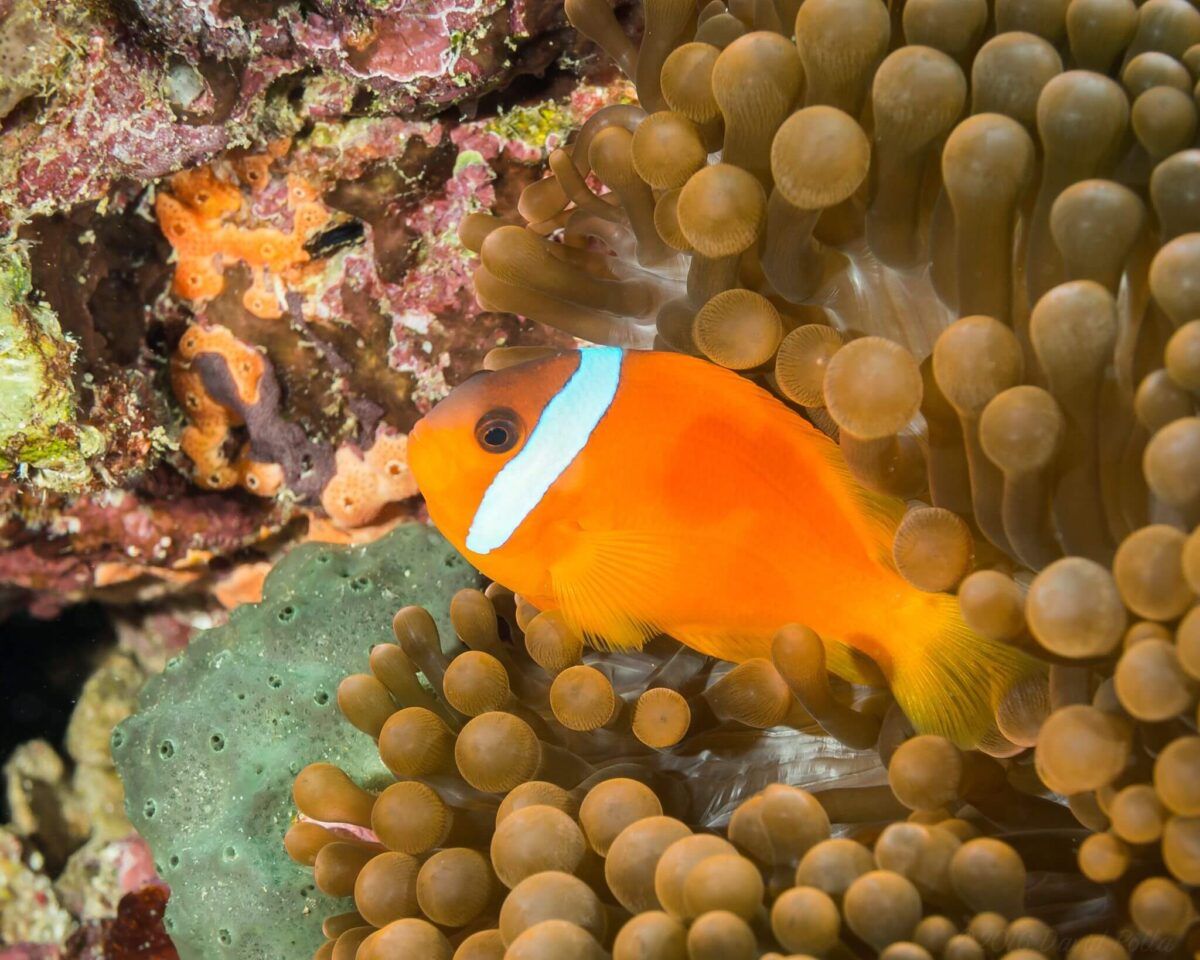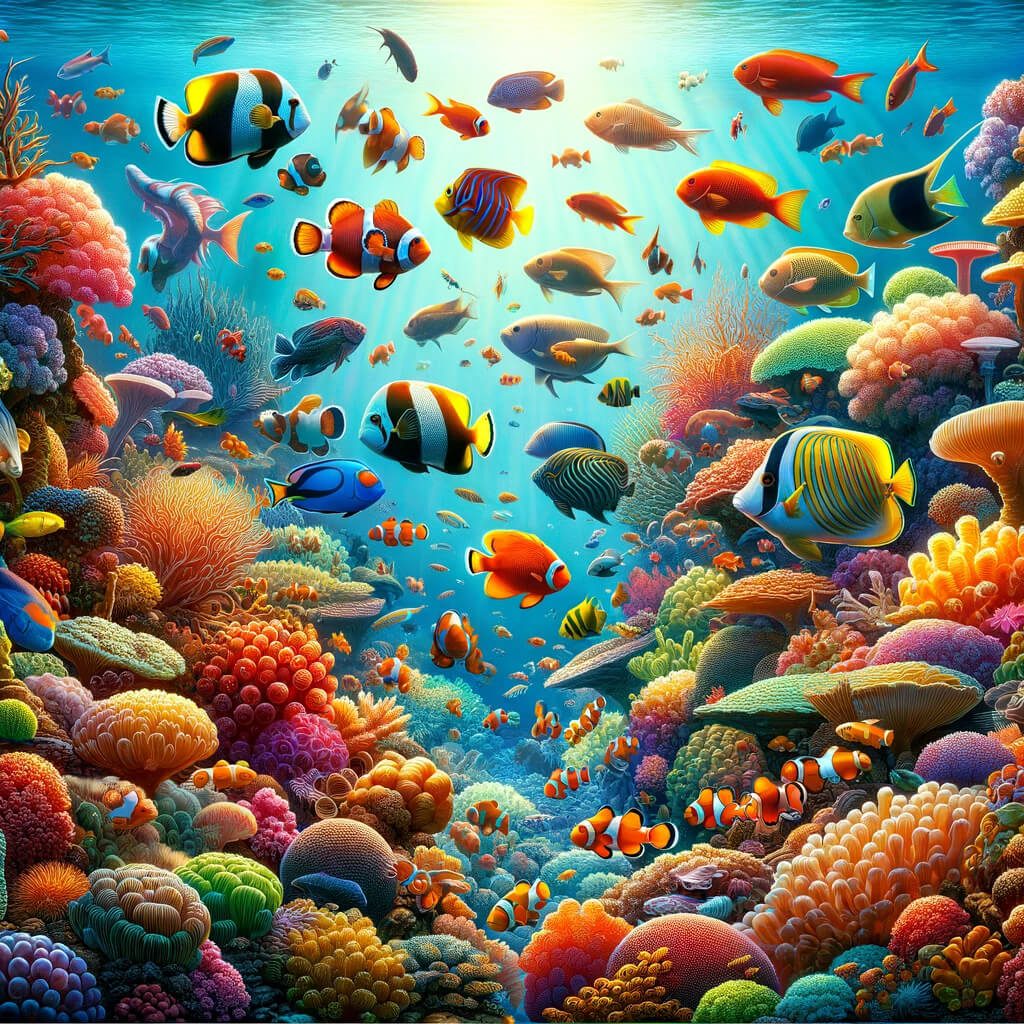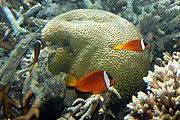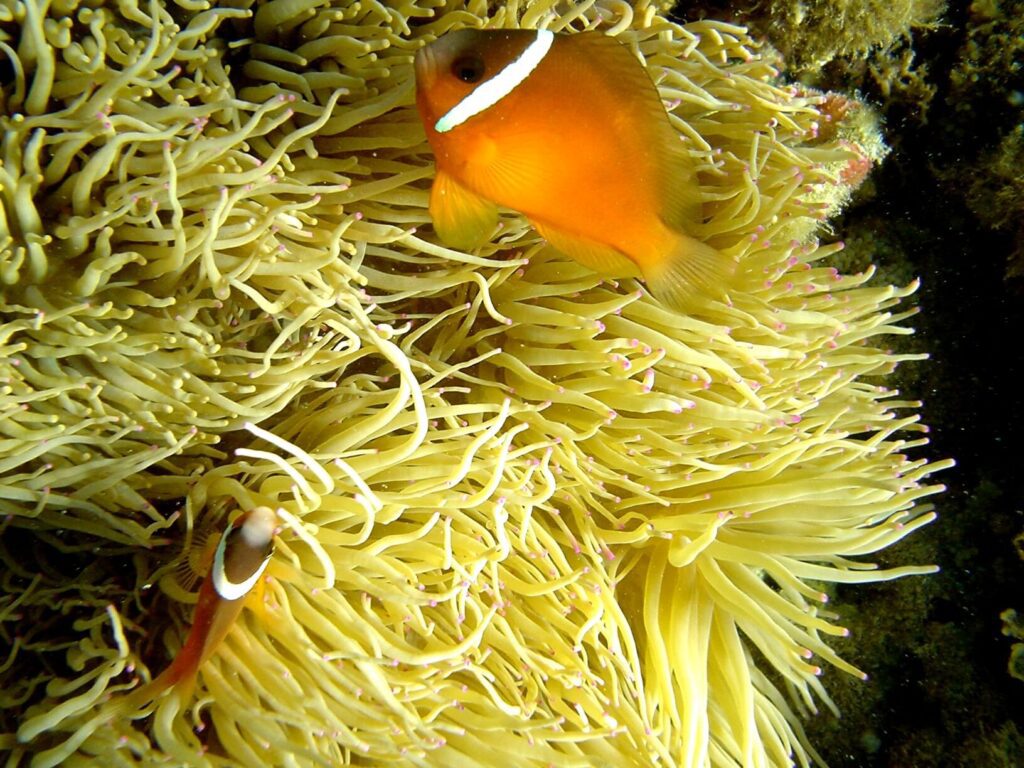All Things Aquatics and DIY aAquarium Hobby
Amphiprion barberi (Barber's Clownfish)

Meet -
Barber's Clownfish

Species Characteristics
Welcome to our comprehensive care guide for Amphiprion barberi, Barber's Clownfish. Whether you're a beginner in marine aquariums or an experienced hobbyist, understanding the care requirements of this vibrant reef aquarium fish is essential for its well-being and longevity.
Barber's Clownfish, or Amphiprion barberi, is a clownfish found in the western Pacific Ocean. This beautiful fish is known for its striking colours, playful behaviour, and fascinating symbiotic relationships with sea anemones in the wild. This guide will explore everything you need to learn about caring for Amphiprion barberi in your marine aquarium, from setting up the ideal habitat to maintaining their health and nutrition.
Join us on this journey as we delve into the world of Barber's Clownfish and equip you with the knowledge and insights needed to ensure their well-being in your aquarium. Let's dive in!
Key Takeaways:
- Understand the taxonomy and classification of Amphiprion barberi and its natural habitat and distribution in the Pacific Ocean.
- Learn about the physical characteristics and unique markings of Barber's Clownfish, including gender differences and colour variations.
- Discover the ideal aquarium requirements for this species, including tank size, water parameters, and suitable tank mates.
- Explore essential care practices, including disease prevention and general maintenance for a sustainable marine ecosystem.
- Gain insights into the proper diet and feeding regimen for Amphiprion barberi, ensuring their nutritional needs are met.
Table of Contents
Introduction
Welcome to section 2 of our comprehensive guide on caring for Amphiprion barberi, also known as Barber’s Clownfish or Fijian Dusky Anemonefish. This section will delve into this captivating marine fish species’ taxonomy, classification, natural habitat, and distribution.
Taxonomy and Classification
Amphiprion barberi belongs to the Animalia kingdom and is classified under the Actinopterygii class, Perciformes order, Pomacentridae family, and Amphiprion genus. Its scientific name, Amphiprion barberi, is derived from its unique characteristics and naming conventions.
Natural Habitat and Distribution
Barber’s Clownfish is predominantly found in the western Pacific Ocean, inhabiting the warm tropical waters surrounding Fiji, Tonga, and Samoa. These vividly coloured anemonefish thrive in the coral reef ecosystems, forming symbiotic relationships with sea anemones.
Their natural habitat provides the ideal conditions for survival and interaction with other marine species. The Pacific Ocean is renowned for its rich marine biodiversity, making it a haven for diverse fish species, including Amphiprion barberi.
Physical Description and Characteristics
Amphiprion barberi, also known as Barber’s Clownfish or Fijian Dusky Anemonefish, exhibits a striking physical appearance and unique characteristics, making it a popular choice among marine fish enthusiasts. This species showcases a mesmerizing array of colours and markings, contributing to its distinct beauty and charm.
Colors and Markings
Vibrant and eye-catching colours characterize the clownfish’s physical appearance. Amphiprion barberi typically features an elegant combination of dark brown or blackish hues on its body, accented by contrasting white bands on its head, tail, and pectoral fins.

These white bands are often outlined with thin black lines, enhancing the fish’s overall visual appeal.
Additionally, this species may exhibit variations in colouration based on its geographic location. For example, some populations of Amphiprion barberi in the Fiji Islands showcase deeper black markings and a more intense colouration than those found in other regions. These colour variations add an element of uniqueness to each fish.
The markings of Amphiprion barberi contribute to its ability to blend in with the surrounding environment and seek protection among sea anemones. The clownfish’s dark colouration also helps it camouflage, providing a natural defence mechanism against potential predators.
Gender Differences
Male and female clownfish can be distinguished by their physical characteristics. Males tend to be slightly smaller than females, with a more streamlined body shape. They also possess a more pronounced dorsal fin, which is often longer and more pointed than that of females.
While both male and female clownfish feature iconic colouration and markings, subtle variations in the intensity and pattern of colours between genders may be noticeable. These differences may be more noticeable during breeding periods when male clownfish exhibit more vibrant colours to attract females.
Varieties
Different varieties may exist within the species Amphiprion barberi based on geographic location or specific breeding efforts. These variations can range from slight differences in colouration to more significant patterning and marking placement deviations. Each variety adds its unique beauty and charm to the overall species.
Grades
In the aquarium fish grading system, clownfish varieties and individuals are often classified into different grades based on their colour intensity, pattern clarity, and overall visual appeal.
Higher grades are typically associated with fish displaying more vibrant colours, well-defined markings, and an overall harmonious appearance. The grading system allows enthusiasts to choose fish that meet their preferences and aesthetic desires.
Behaviour and Temperament
Amphiprion barberi is known for its fascinating behaviour and playful temperament. These clownfish are generally peaceful and can be kept in communal aquariums with other compatible species.
However, it is crucial to provide ample space and suitable hiding spots to accommodate their territorial instincts.
Barber’s Clownfish often form symbiotic relationships with sea anemones, seeking refuge within the tentacles of these invertebrates. This mutualistic partnership benefits both the clownfish and the anemone, providing the fish with protection and the anemone with food scraps and improved water circulation.
Amphiprion barberi will exhibit similar behaviour in aquariums without sea anemones by seeking refuge in rock crevices, coral structures, or other suitable hiding places.
Creating a stress-free environment with adequate hiding spots and ample swimming space will help promote natural behaviour and overall well-being in these fascinating marine fish.
Aquarium Requirements
Creating the right environment for Amphiprion barberi in your aquarium is crucial for its health and well-being. This section will discuss this species’ ideal tank size and layout, considering their need for swimming space and the possibility of hosting sea anemones. We will also explore the water parameters necessary for maintaining a healthy marine aquarium and explore suitable tank mates for Amphiprion barberi, highlighting potential conflicts and compatibility with live plants and invertebrates. By understanding and meeting the aquarium requirements of this species, aquarists can provide a thriving habitat for their Barber’s Clownfish.
Ideal Tank Size and Layout
When setting up an aquarium for Amphiprion barberi, it is essential to provide sufficient swimming space and a suitable layout. A tank size of at least 30 gallons (113 litres) is recommended to accommodate their active nature.
Additionally, incorporating rock structures and live plants can create hiding spots and mimic their natural habitat. It is also essential to consider the possibility of having sea anemones in the tank, as clownfish form a symbiotic relationship with them.
Water Parameters
Maintaining proper water parameters is vital for the health of Amphiprion barberi. The ideal temperature range for this species is 75-82°F (24-28°C), and the pH should be kept between 8.1 and 8.4. Salinity levels should be maintained at 1.023-1.025 specific gravity. Regular monitoring and adjustments are necessary to ensure stable conditions and prevent stress-related issues.
Suitable Tank Mates and Potential Conflicts
Choosing suitable tank mates for Amphiprion barberi is crucial to avoid aggression and conflicts. Peaceful marine fish species such as gobies, dottybacks, and wrasses can be compatible companions in the aquarium. However, it is essential to research the individual compatibility of specific species to ensure a harmonious community tank.
Compatibility with Live Plants and Invertebrates
Under the right conditions, Amphiprion barberi can coexist with live plants and certain invertebrates. Hardy, saltwater-tolerant plant species like Caulerpa or macroalgae can add visual appeal to the tank and provide natural hiding places.
Compatible invertebrates include cleaner shrimp, coral-banded shrimp, certain species of snails, and hermit crabs. However, caution should be exercised with delicate and sessile invertebrates, as clownfish may exhibit occasional nipping behaviour.
Barber’s Clownfish Care
Proper care of your Amphiprion barberi is essential for promoting health and longevity. This section will provide a comprehensive care guide, including general aquarium maintenance, water quality management, and disease prevention information.
We will also explore common saltwater fish diseases and common fish health issues that can affect this species, along with recommended treatments and preventative measures to ensure the well-being of your Barber’s Clownfish.
Diet and Feeding
Providing a proper diet and feeding regimen is vital for the health and growth of your Amphiprion barberi. Understanding your Clownfish’s dietary preferences and providing suitable food options is also essential to meet their nutritional needs.
Dietary Preferences
Amphiprion barberi are omnivorous fish that feed primarily on algae and zooplankton in their natural habitat. In an aquarium setting, their diet should include various foods to ensure they receive all the necessary nutrients for optimal health.
Recommended Foods and Feeding Schedule
When feeding your Barber’s Clownfish, offering a balanced mix of live and frozen foods is essential. Suitable options include:
- Live brine shrimp
- Mysis shrimp
- Daphnia
- Copepods
- Frozen fish food pellets
- Frozen marine algae
You should feed your Clownfish small amounts multiple times a day rather than a single large meal. This mimics their natural feeding habits and improves digestion and nutrient absorption.
Tips on Ensuring a Balanced and Nutritious Diet
Here are some tips to ensure your Barber’s Clownfish receive a balanced and nutritious diet:
- Offer a variety of food options to provide a diverse range of nutrients.
- Rotate between live and frozen foods to simulate their natural feeding habits.
- Avoid overfeeding, as Clownfish are prone to obesity and related health issues.
- Monitor their feeding behaviour to ensure all fish have access to food and are eating properly.
- Consider adding vitamin and mineral supplements to their diet to enhance overall nutrition.
Following these guidelines, you can provide your Amphiprion barberi with a balanced and nutritious diet, promoting their overall well-being, vibrant colouration, and healthy growth.
Breeding and Reproduction
Breeding Amphiprion barberi in captivity can be a rewarding and exciting endeavour. To successfully breed these fish, it is essential to understand their reproduction process and provide the optimal conditions for breeding.
In this section, we will explore the sexing of clownfish, their breeding behaviour and conditions, and the care required for their eggs and fry. We will also address the challenges of breeding marine fish in captivity.
Sexing
Sexing clownfish is essential for successful breeding. To determine the sex of Amphiprion barberi, observe their behaviour and physical characteristics. Males are typically smaller, more aggressive, and have more vibrant colours than females. Conversely, females tend to be larger and have more dominant and aggressive behaviour.
Breeding Behavior and Conditions
Creating an environment miming their natural habitat and stimulating breeding behaviour is essential for successful reproduction. A suitable breeding tank with live rock, hiding spots, and a proper lighting cycle can encourage courtship and spawning. Maintaining stable water parameters, such as temperature and salinity, is crucial for breeding.
Care of Eggs and Fry
Once spawning occurs, caring for the eggs and fry properly is essential. Clownfish eggs are typically laid on a flat surface near their host anemone. Ensure the breeding tank has a clean substrate to attach the eggs. Monitor the eggs closely and maintain pristine water conditions to prevent fungus and bacterial growth.

After hatching, the fry will consume their yolk sacs before becoming free-swimming. At this stage, it is crucial to provide them with suitable food, such as rotifers or newly hatched brine shrimp. Gradually introduce larger food particles as they grow. Regular water changes and monitoring of water parameters are essential for their development.
Challenges in Breeding in Captivity
Breeding marine fish in captivity comes with its challenges. Clownfish are known for their complex reproductive behaviours, and successfully rearing the fry requires attention to detail. Maintaining optimal water quality, providing the correct diet, and preventing diseases and parasites are some challenges aquarists may face in the breeding process.
Being prepared, conducting thorough research, and seeking advice from experienced breeders can help overcome these challenges. With patience and dedication, breeding Amphiprion barberi can be a fulfilling experience that contributes to the conservation of this beautiful species.
Summary
Summary
Throughout this article, we have explored the fascinating world of Amphiprion barberi, commonly known as Barber's Clownfish. By understanding the taxonomy and classification of this species, we can appreciate its unique place in the marine ecosystem. Creating the right environment in our aquariums is crucial, from providing the ideal tank size and layout to maintaining appropriate water parameters. By ensuring compatibility with suitable tank mates and promoting a balanced diet, we can support the health and well-being of these vibrant and playful fish.
When caring for Amphiprion barberi, we must be aware of common diseases that can affect them and take preventive measures to safeguard their well-being. Regular aquarium maintenance and water quality management are crucial in maintaining optimal conditions. By embracing responsible breeding practices, we can contribute to the propagation of this captivating species in captivity. While there may be challenges, successful breeding can be achieved with patience and dedication.
In conclusion, keeping and caring for Amphiprion barberi in our marine aquariums requires a holistic approach. By understanding the key points discussed in this article, we can create a thriving environment for Barber's Clownfish. Remember to prioritize their taxonomy, provide aquarium requirements, offer proper care and nutrition, and remain vigilant in disease prevention. With these essential tips in mind, may you embark on a journey of joy and success in your aquarium journey with Amphiprion barberi.
Source Links
FAQ's
What is the scientific name of Barber's Clownfish?
The scientific name of Barber's Clownfish is Amphiprion barberi.
Where is Barber's Clownfish found in the wild?
Barber's Clownfish is found in the western Pacific Ocean, specifically in regions such as Fiji, Tonga, and Samoa.
What are the physical characteristics of Barber's Clownfish?
Barber's Clownfish is known for its vibrant colors and unique markings. It has a distinctive appearance with variations in coloration. Additionally, males and females may differ in appearance and behavior.
What are the aquarium requirements for Barber's Clownfish?
Barber's Clownfish require a tank that provides ample swimming space and the possibility of hosting sea anemones. Maintaining suitable water parameters and ensuring compatibility with tank mates and live plants or invertebrates are also important considerations.
How do I provide proper care for Barber's Clownfish?
Proper care for Barber's Clownfish involves general aquarium maintenance, maintaining water quality, and taking preventative measures to avoid common diseases. Regular observation and prompt action are essential for their wellbeing.
What should I feed my Barber's Clownfish?
Barber's Clownfish have dietary preferences that include both live and frozen foods. It is important to establish a feeding schedule and provide a balanced and nutritious diet to promote their health and vibrant coloration.
Is breeding Barber's Clownfish in captivity possible?
Yes, breeding Barber's Clownfish in captivity is possible. It involves understanding the sexing process, creating suitable breeding conditions, and providing care for the eggs and fry. However, breeding this species may present certain challenges.
What are the key points to remember for keeping Barber's Clownfish?
To successfully keep and care for Barber's Clownfish, it is important to understand their taxonomy, provide the appropriate aquarium requirements, offer proper care, and ensure a balanced diet. Attention to these key aspects will create a thriving environment for this species in your marine aquarium.
